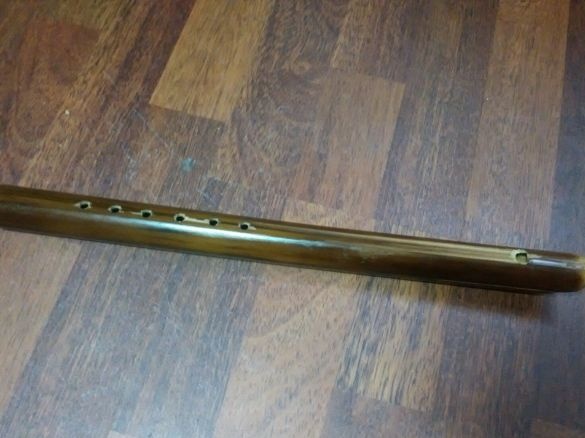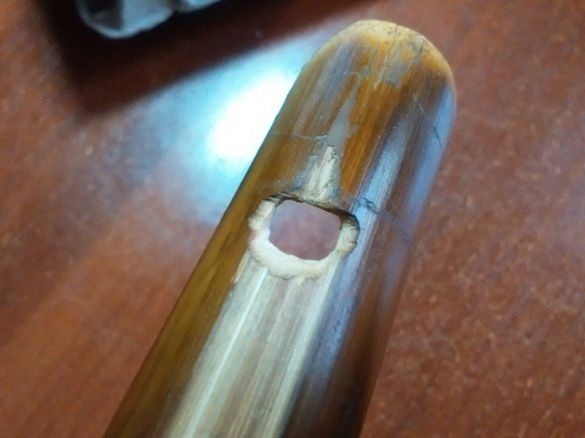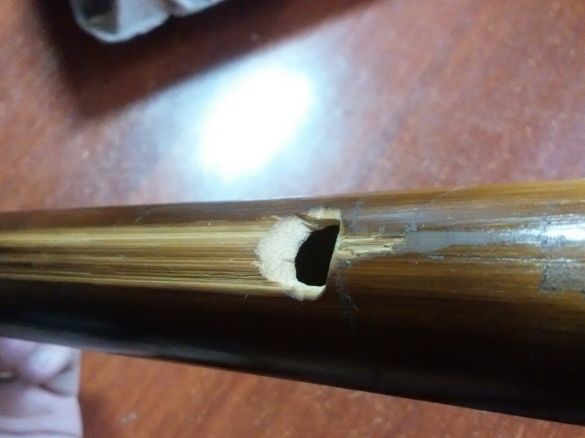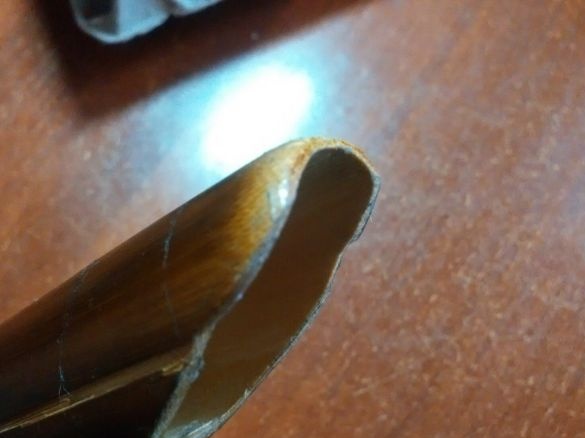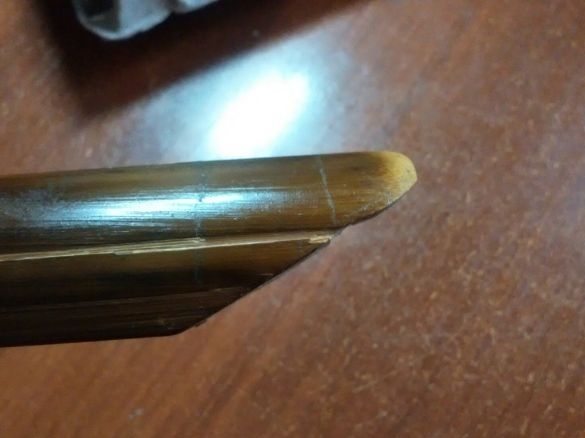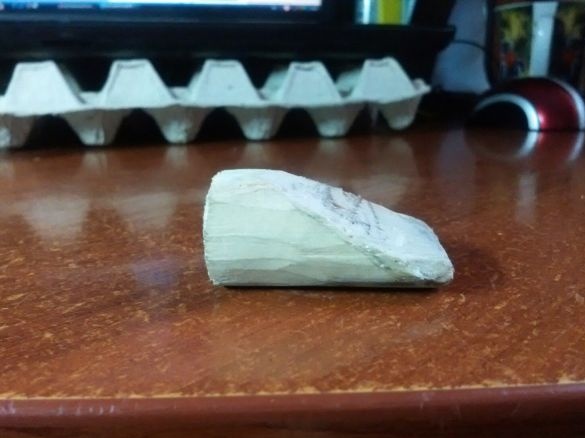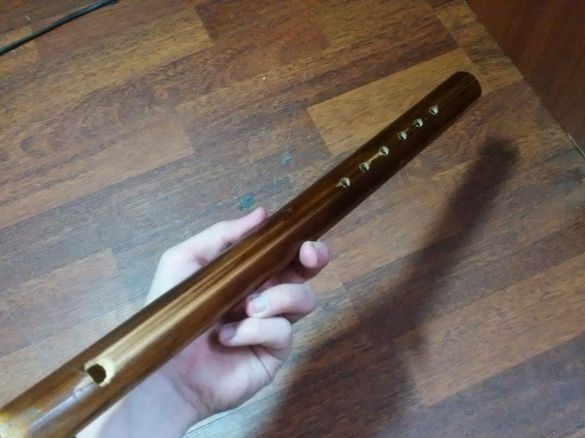Hello humanity! Today I will tell you how to make a flute do it yourself. The flute, in our case, the flute, is an old wind musical instrument. The appearance of the prototype flute dates back almost 35 thousand years ago, which makes it one of the oldest tools. And the familiar flute became known in Egypt, five thousand years ago, and is still the main instrument in the Middle East. Folk or folk rock is not without it. Those who are familiar with fantasy worlds know that the pipe is one of the elves' favorite tools. But in our reality, playing the flute will brighten up winter evenings. And you can make this wonderful tool in less than an hour.
For the manufacture we need:
• Wooden tube (reed, bamboo, reed, etc.)
• A piece of wood or cork
• Drills for 2; 4.2 and 6 mm and something that can be drilled (screwdriver, drill, engraver)
• File
• Canvas for hacksaw
Barrel flute
The first step is to choose the body of the pipe. Any hollow pipe, whether it be reed, reeds or plumbing PVC pipe, will do. I found a great bamboo pipe.
It is not quite round, inner diameters are 23 and 25 mm. I sawed 400 mm, a flute will be of such length. Although it was necessary to saw off 300 mm, as usual, I mixed everything up.
From one end we make two holes close to each other, the borders of which should be located at a distance of 40 mm from the edge. First, I marked the holes with a 2 mm drill, and then drilled with a 4.2 mm drill. Next, with a file, make the hole rectangular, with a length of 5 mm and a width of 7 mm. And grind one side of the window at an angle of 30-45 degrees, all the same file. This is the whistle hole. The sound quality will depend on the sharpness and smoothness of the bevel.
Next, we make six game valve openings (the markup was earlier). The first hole will be 60 mm from the lower end of the flute, the rest in increments of 20 mm. Again we make holes with a 2 mm drill and drill a 6 mm drill. In general, such drills came up to me. The tuning principle is this: the larger the hole, the higher the sound, so you can start drilling with 4 mm. The main thing is not to overdo it, because it will not work to reduce the hole.You need to start drilling from the bottom hole. Using the tuner, we will adjust the flute in natural major. We drill the lower one and blow it, adjust it according to the tuner, then we drill the second one. The second hole is rebuilt when the first is open, and so on. The following series of notes should be obtained: la sharp, la, salt, fa, re sharp, re, do.
We grind all the holes with sandpaper, but very fine so as not to damage the natural color of the bamboo.
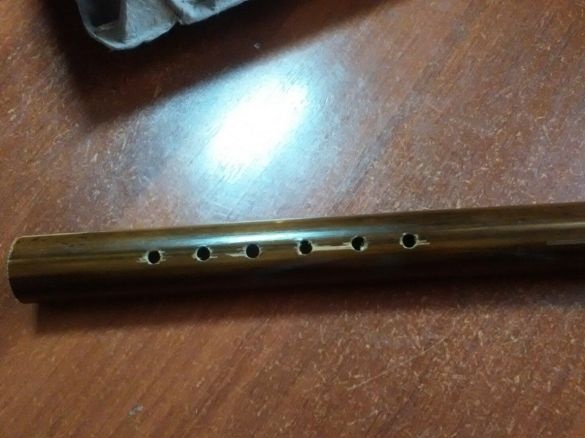 [/ center]
[/ center]
Whistle
Now, from the end where you made the hole for the whistle, you need to make a bevel. From the edge down, we retreat 4-5 mm, and to the left 40 mm. We make a bevel with a blade for a hacksaw.
Now we make a sleeve from a piece of wood or cork. At first I gave the piece of wood a round shape, then made the same bevel as on the flute itself. I found a soft tree, so I did everything with a knife. From above it is necessary to make a flat face, departing from the edge of 1 mm, as in a normal whistle. It is impossible to make too big a bevel, there will simply be no whistle. Insert the sleeve into the "body".
I made the sleeve too small. She should enter the flute tightly and sit securely there. I had to glue all the spaces with hot glue. I missed the sleeve itself with PVA glue before inserting it into the flute.
At this, the manufacture of the pipe ends. You can already get the first sounds. Again, this is ideal for learning. Since a good flute is worth a lot, not to be confused with a recorder. And our home-made flute has an acceptable sound, and the manufacturing process took half an hour. The tool can be decorated to your taste, but I have a bamboo and so it looks good.
For the manufacture we need:
• Wooden tube (reed, bamboo, reed, etc.)
• A piece of wood or cork
• Drills for 2; 4.2 and 6 mm and something that can be drilled (screwdriver, drill, engraver)
• File
• Canvas for hacksaw
Barrel flute
The first step is to choose the body of the pipe. Any hollow pipe, whether it be reed, reeds or plumbing PVC pipe, will do. I found a great bamboo pipe.
It is not quite round, inner diameters are 23 and 25 mm. I sawed 400 mm, a flute will be of such length. Although it was necessary to saw off 300 mm, as usual, I mixed everything up.
From one end we make two holes close to each other, the borders of which should be located at a distance of 40 mm from the edge. First, I marked the holes with a 2 mm drill, and then drilled with a 4.2 mm drill. Next, with a file, make the hole rectangular, with a length of 5 mm and a width of 7 mm. And grind one side of the window at an angle of 30-45 degrees, all the same file. This is the whistle hole. The sound quality will depend on the sharpness and smoothness of the bevel.
Next, we make six game valve openings (the markup was earlier). The first hole will be 60 mm from the lower end of the flute, the rest in increments of 20 mm. Again we make holes with a 2 mm drill and drill a 6 mm drill. In general, such drills came up to me. The tuning principle is this: the larger the hole, the higher the sound, so you can start drilling with 4 mm. The main thing is not to overdo it, because it will not work to reduce the hole.You need to start drilling from the bottom hole. Using the tuner, we will adjust the flute in natural major. We drill the lower one and blow it, adjust it according to the tuner, then we drill the second one. The second hole is rebuilt when the first is open, and so on. The following series of notes should be obtained: la sharp, la, salt, fa, re sharp, re, do.
We grind all the holes with sandpaper, but very fine so as not to damage the natural color of the bamboo.
 [/ center]
[/ center]Whistle
Now, from the end where you made the hole for the whistle, you need to make a bevel. From the edge down, we retreat 4-5 mm, and to the left 40 mm. We make a bevel with a blade for a hacksaw.
Now we make a sleeve from a piece of wood or cork. At first I gave the piece of wood a round shape, then made the same bevel as on the flute itself. I found a soft tree, so I did everything with a knife. From above it is necessary to make a flat face, departing from the edge of 1 mm, as in a normal whistle. It is impossible to make too big a bevel, there will simply be no whistle. Insert the sleeve into the "body".
I made the sleeve too small. She should enter the flute tightly and sit securely there. I had to glue all the spaces with hot glue. I missed the sleeve itself with PVA glue before inserting it into the flute.
At this, the manufacture of the pipe ends. You can already get the first sounds. Again, this is ideal for learning. Since a good flute is worth a lot, not to be confused with a recorder. And our home-made flute has an acceptable sound, and the manufacturing process took half an hour. The tool can be decorated to your taste, but I have a bamboo and so it looks good.

